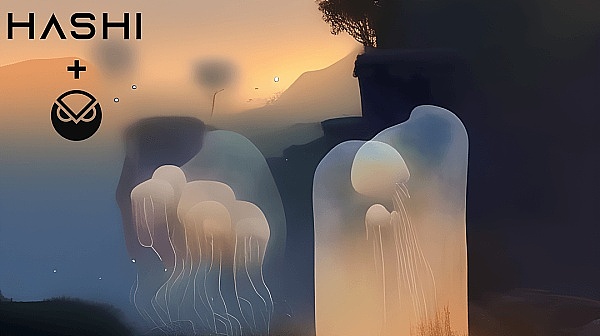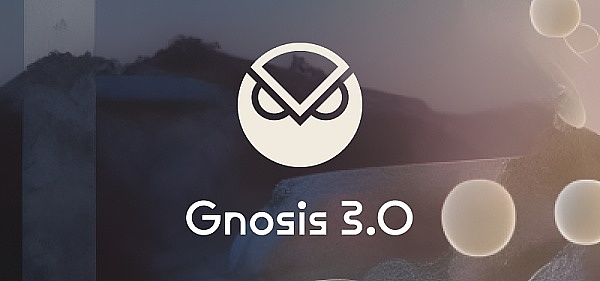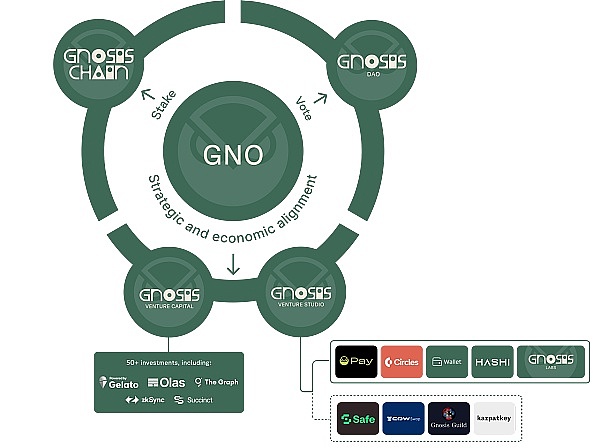As one of the pioneers of blockchain technology in the growing ecosystem of Web3, Gnosis has come a long way since its first launch on Ethereum in 2016. As a sidechain of Ethereum, Gnosis ($GNO) has the characteristics of a sidechain, but its functions and performance are more similar to Layer1 (L1) blockchains. Gnosis has a staggering fully diluted market capitalization of $778 million, with 86% of tokens in circulation and a total value locked (TVL) of $286 million on the chain.
On the Gnosis chain, major decentralized finance (DeFi) applications such as Aave, Maker sub-protocol Spark, and Balancer are active, especially RealT, which has a TVL of $104 million, showing Gnosis' strong potential in tokenizing real-world assets (RWA). With the launch of Gnosis 3.0, its ecosystem has begun to focus on payments and financial infrastructure. In the following, we will briefly introduce some information about Gnosis.

Gnosis Chain
Gnosis Chain, formerly known as xDai Chain, was officially launched in October 2018 and is an important side chain based on Ethereum. After merging with Gnosis, the chain was officially renamed Gnosis Chain in December 2021 according to the GIP16 proposal. As an EVM (Ethereum Virtual Machine) compatible chain, Gnosis Chain allows Ethereum developers to migrate and deploy smart contracts at a very low cost, which greatly reduces the development threshold and cost.
Gnosis Chain adopts a unique dual-token model, which consists of the stablecoin XDAI and the governance token GNO (formerly STAKE). XDAI is a stablecoin pegged 1:1 to the US dollar and is used for transactions and payment of fees, while GNO supports the underlying POSDAO consensus mechanism. This model not only maintains the stability of the network, but also provides an efficient governance method. When a user converts DAI to XDAI through a cross-chain bridge, the DAI will be locked, and Gnosis Chain will generate an equivalent amount of XDAI and send it to the user. Conversely, XDAI will be destroyed and DAI will be sent to the user's Ethereum wallet.
The cross-chain bridging methods supported by Gnosis Chain include xDai Bridge and Omni Bridge. The former is designed specifically for XDAI, while the latter can support cross-chain tokens between multiple chains. In addition, GNO token holders can directly participate in on-chain governance by initiating proposals and participating in voting. Users can also participate in block production and on-chain security maintenance by running a full node and staking GNO to become a validator.
In terms of consensus mechanism, Gnosis Chain adopts a Proof of Stake (PoS) consensus algorithm called POSDAO, which is an algorithm based on the BFT (Byzantine Fault Tolerance) consensus protocol, ensuring the decentralization, fairness and energy saving of the network. This consensus mechanism has been in effect since April 2020 and will last until the Ethereum network upgrade and merger. In December 2022, Gnosis Chain successfully merged with Gnosis Beacon Chain and became one of its shards. This time further integrated the Gnosis network and optimized its role in the Ethereum ecosystem.
Through innovative technology and forward-looking strategies, Gnosis Chain not only plays an important role in the Ethereum ecosystem, but also provides critical infrastructure for the development of decentralized applications (dApps), thereby promoting the development of the entire ecosystem and the transparency of governance decisions.
GNO: The Core Token and Future Outlook in the Gnosis Ecosystem
GNO, as the native token of the Gnosis ecosystem, plays multiple key roles. It is not only the staking token of Gnosis, but also the governance token of GnosisDAO, which makes it central to the entire Gnosis ecosystem. Built on the Ethereum protocol, Gnosis is a decentralized prediction platform that utilizes the PoS mechanism, providing users with an open and flexible environment to participate in and create customizable prediction markets.
GNO's market positioning is unique. As one of the earliest sidechains of Ethereum, Gnosis Chain stands out for its independence and EVM compatibility, which enables it to support smart contracts and DApps while maintaining independence and autonomy of operation. This structure allows Gnosis Chain to achieve rapid transfer of assets through specific mechanisms while ensuring transaction security.
In today's competitive crypto market, GNO faces competition from other sidechains and Layer2 solutions such as Optimism. Sidechains like Gnosis provide independently operated blockchains with their own consensus mechanisms and security models, while Layer2 solutions operate under the security framework of the Ethereum mainchain and provide lighter transaction processing solutions. Although sidechains may not be as secure as Layer2 solutions that rely on the Ethereum mainchain, Gnosis provides unique value through its independence, especially in asset interoperability and diversity of application scenarios.
In terms of data security and market performance, GNO has shown strong potential. Although code security has always been a key focus of the development team, the Gnosis ecosystem has received a positive response from the capital market. Gnosis's total locked value (TVL) of $286 million is one of the key indicators of its success. Looking ahead, the management style of the Gnosis team and community demonstrates its commitment to robust operations, indicating that significant growth may be achieved in the new bull market cycle.
Taking all factors into consideration, the design advantages and market performance of Gnosis Chain and GNO tokens, as well as their practical applications in DeFi and prediction markets, make them strong competitors for blockchain investment and development. Despite the challenges, such as the need to further improve code auditing and security, the Gnosis ecosystem still demonstrates great growth potential and market appeal, and its future development is worth looking forward to.
Gnosis 3.0: The bridge between blockchain technology and everyday applications

Gnosis was launched as an Ethereum-based prediction market platform in 2015. After going through the transformation from a prediction market platform (Gnosis 1.0) to Ethereum core infrastructure (Gnosis 2.0), it has now entered its most ambitious development phase: Gnosis 3.0. In this phase, Gnosis is no longer just an infrastructure provider, but focuses on innovating payment and financial infrastructure through a series of projects connected by the GNO token, aiming to bridge the gap between blockchain technology and everyday use cases for the masses.
The core of Gnosis 3.0 is to strategically shift to an open financial track and popularize DeFi tools through applications such as Gnosis Pay and Gnosis Wallet. These applications can not only accelerate the democratization of financial services, but also provide users with more secure and transparent payment and financial service solutions. In addition, Gnosis 3.0 also emphasizes the reform of existing traditional finance, expecting to replace certain businesses in the traditional financial system with blockchain infrastructure.

In terms of technology and governance structure, Gnosis Chain continues to be the core of Gnosis 2.0 and 3.0, ensuring network security through the validator mechanism of staking GNO. Gnosis DAO, as the governance infrastructure for GNO token holders, controls the Gnosis treasury and other key assets, such as ENS domain names, thereby indirectly strengthening its influence on the Gnosis ecosystem. In addition, Gnosis Ventures not only supports and incubates early-stage projects, but also provides extensive support to the Gnosis ecosystem by investing in third-party startups.
During this phase, Gnosis Ventures has invested in several ecological projects with significant economic potential, including Safe and CoW DAO. This strategy not only enhances the economic vitality within the Gnosis ecosystem, but also contributes to the prosperity of the entire blockchain industry.
The future outlook of Gnosis 3.0 focuses on combining the practical application of blockchain technology with the daily needs of ordinary users, and promoting the popularity and acceptance of blockchain technology by providing more flexible and user-friendly solutions. In this way, Gnosis hopes to lead blockchain technology from a field that focuses mainly on technical infrastructure to a practical technology platform that can truly meet the needs of ordinary users.
Conclusion
Through continuous technological innovation and community-driven governance, Gnosis is shaping a more open and fairer digital economic future. As blockchain technology becomes more widely integrated into daily life, Gnosis's journey sets a benchmark for the entire industry, demonstrating the importance of continuous innovation and adaptability to change.
 JinseFinance
JinseFinance
 JinseFinance
JinseFinance JinseFinance
JinseFinance Brian
Brian JinseFinance
JinseFinance Max Ng
Max Ng Darren
Darren Cointrust
Cointrust Coindesk
Coindesk Bitcoinist
Bitcoinist 链向资讯
链向资讯